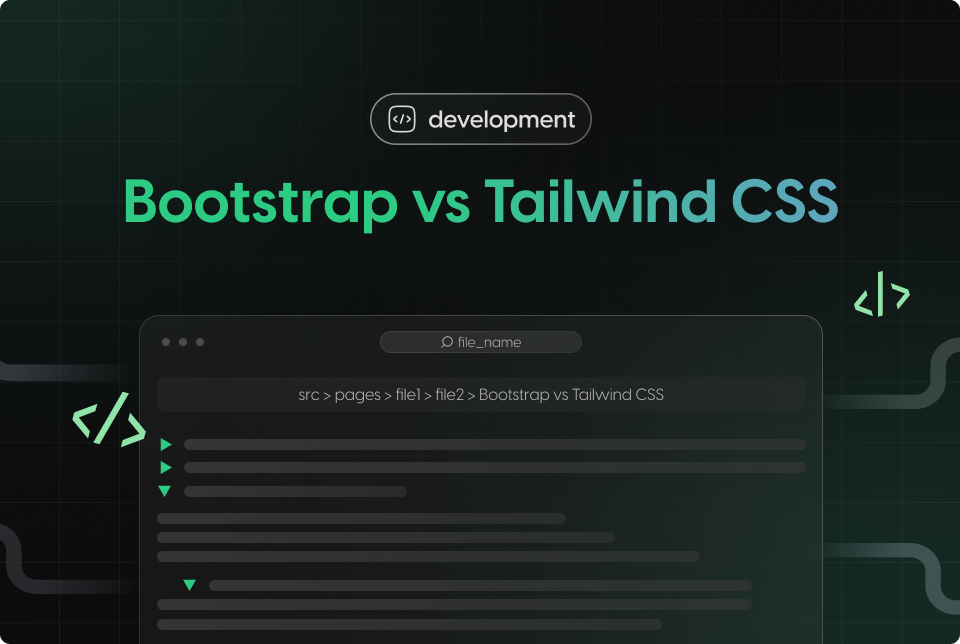
Ivan Traykov
27 Sep
5 mins read
- Copy link
Bootstrap vs. Tailwind CSS: Which Framework Should You Choose?

In the fast-paced world of web design, selecting the right CSS framework can significantly impact the efficiency and success of your projects. Bootstrap and Tailwind CSS are two of the most popular frameworks available today, each offering a unique approach to building responsive, visually appealing websites. In this post, we’ll explore the key features, advantages, and ideal use cases for both Bootstrap and Tailwind CSS, helping you determine which framework best suits your needs.
Understanding Bootstrap
Bootstrap, developed by Twitter, is one of the most widely used CSS frameworks. It provides a comprehensive set of pre-designed components and utilities that make it easy to create responsive, mobile-first websites.
Key Features of Bootstrap:
Pre-Designed Components:
Bootstrap offers a vast library of pre-styled components such as buttons, forms, modals, and navigation bars, which can be easily integrated into your projects.
Grid System:
Bootstrap’s 12-column grid system allows for flexible and responsive layouts, making it simple to structure your web pages.
Customization:
Although Bootstrap comes with a predefined style, it also provides extensive customization options through Sass variables and Bootstrap’s theme system.
Documentation and Community:
Bootstrap boasts extensive documentation and a large community, offering a wealth of resources and third-party plugins.
When to Use Bootstrap:
Rapid Prototyping:
Bootstrap is ideal for quickly building prototypes or MVPs (Minimum Viable Products) due to its extensive library of ready-to-use components.
Consistency:
Use Bootstrap when you need to maintain a consistent look and feel across multiple projects.
Beginner-Friendly:
Bootstrap’s ease of use and comprehensive documentation make it a great choice for beginners.
Understanding Tailwind CSS
Tailwind CSS takes a different approach by providing a utility-first framework. Instead of pre-designed components, Tailwind offers low-level utility classes that can be combined to build custom designs without writing any CSS.
Key Features of Tailwind CSS:
Utility-First Approach:
Tailwind’s utility-first approach allows you to style elements directly in your HTML using utility classes, giving you complete control over your design.
Customization:
Tailwind is highly customizable. You can easily extend the framework and configure it to suit your design needs.
Responsive Design:
Tailwind includes built-in responsive design utilities, making it easy to create designs that adapt to different screen sizes.
Performance:
Tailwind’s approach minimizes the amount of CSS you need to write, leading to smaller file sizes and faster load times.
When to Use Tailwind CSS:
Custom Designs:
Tailwind is perfect for projects where you need a unique design that doesn’t rely on predefined styles.
Performance:
Use Tailwind when performance is a priority, as its utility-first approach can result in smaller CSS bundles.
Experienced Developers:
Tailwind requires a deeper understanding of CSS, making it better suited for developers who are comfortable with custom styling.
Comparing Bootstrap and Tailwind CSS
While both frameworks have their strengths, they cater to different needs and preferences. Here’s a closer look at how they compare:
Design Approach:
Bootstrap:
Component-based with predefined styles.
Tailwind CSS:
Utility-first with custom styles.
Customization:
Bootstrap:
Customization is possible but requires overriding predefined styles.
Tailwind CSS:
Highly customizable with a configuration file.
Ease of Use:
Bootstrap:
Beginner-friendly with extensive documentation and predefined components.
Tailwind CSS:
Requires a good understanding of CSS and utility classes.
Performance:
Bootstrap:
Larger file sizes due to predefined components.
Tailwind CSS:
Smaller file sizes with a focus on performance.
Community and Resources:
Bootstrap:
Large community with extensive resources and third-party plugins.
Tailwind CSS:
Growing community with increasing resources and plugins.
Practical Examples
Example 1: Building a Simple Form with Bootstrap Bootstrap provides ready-made form components that you can quickly integrate into your project. Simply include the Bootstrap classes, and your form will have a consistent, professional look.
Example 2: Creating a Custom Button with Tailwind CSS With Tailwind, you can create a unique button by combining utility classes. This approach allows for complete control over the button’s appearance, ensuring it fits perfectly with your design.
Conclusion
Both Bootstrap and Tailwind CSS are powerful frameworks that can enhance your web development process. The choice between them depends on your specific project needs and personal preferences.
Choose Bootstrap
if you need to rapidly develop a consistent, professional-looking website with minimal custom styling.
Opt for Tailwind CSS
if you want full control over your design and prioritize performance and customization.
By understanding the strengths and ideal use cases for each framework, you can make an informed decision that aligns with your project goals and enhances your web development workflow.